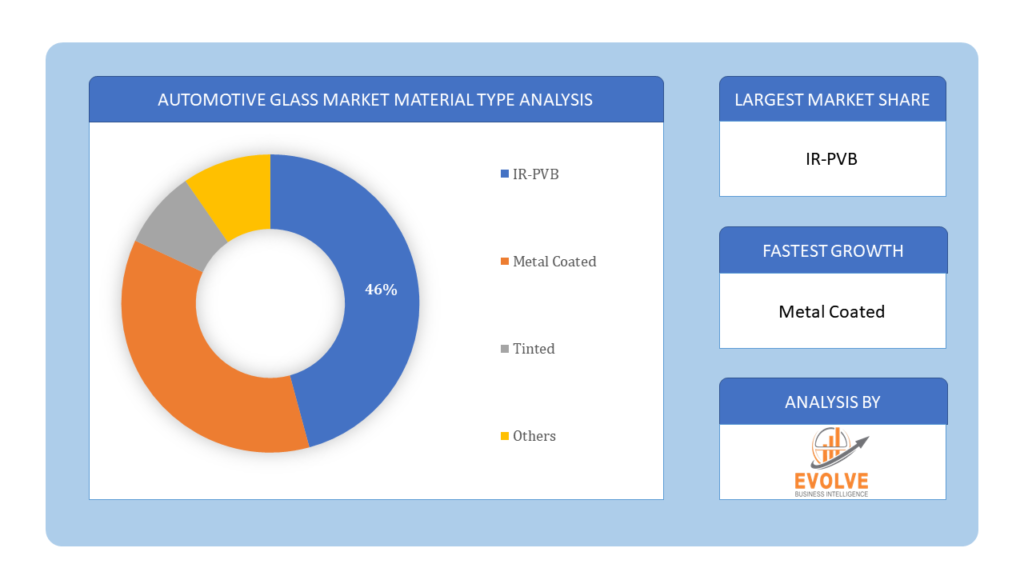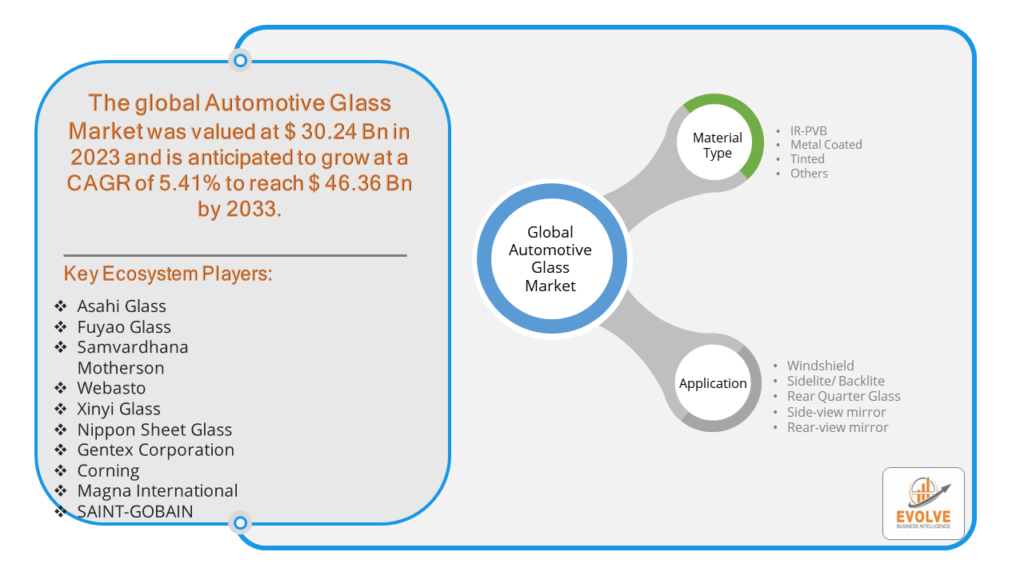Automotive Glass Market Analysis and Global Forecast 2023-2033
$ 1,390.00 – $ 5,520.00Price range: $ 1,390.00 through $ 5,520.00
Automotive Glass Market Research Report: Information By Material Type (Ir-Pvb, Metal Coated, Tinted, Others), By Application (Windshield, Sidelite/ Backlite, Rear Quarter Glass, Side-View Mirror, Rear-View Mirror), and by Region — Forecast till 2033
Page: 169
Automotive Glass Market Overview
The Automotive Glass Market Size is expected to reach USD 46.36 Billion by 2033. The Automotive Glass industry size accounted for USD 30.24 Billion in 2023 and is expected to expand at a compound annual growth rate (CAGR) of 5.41% from 2023 to 2033. The automotive glass market encompasses the Material Typeion and sale of glass Material Types specifically designed for vehicles, including windshields, side and rear windows, and sunroofs. This market is driven by factors such as advancements in glass technology, increasing automotive Material Typeion, and rising consumer demand for enhanced safety and comfort features. Innovations such as laminated glass, smart glass, and lightweight glass are gaining traction. Additionally, the push towards electric and autonomous vehicles is propelling the need for advanced glass solutions. Key players in the market focus on Material Type innovation, strategic partnerships, and expanding manufacturing capacities to meet global demand.
Global Automotive Glass Market Synopsis
The COVID-19 pandemic has led to supply chain disruptions leading to supply shortages or lower demand in the Automotive Glass market. The travel restrictions and social-distancing measures have resulted in a sharp drop in consumer and business spending and this pattern is to continue for some time. The end-user trend and preferences have changed due to the pandemic and have resulted in manufacturers, developers, and service providers adopting various strategies to stabilize the company.
Automotive Glass Market Dynamics
The major factors that have impacted the growth of Automotive Glass are as follows:
Drivers:
Ø Technological Advancements
One of the primary drivers is the continuous innovation in glass technology. Developments in laminated and tempered glass have significantly enhanced safety by reducing the risk of shattering. Furthermore, advancements such as smart glass and heads-up displays (HUDs) integrate functionalities like tint adjustment, heat insulation, and the projection of critical information, enhancing driver comfort and safety.
Restraint:
- High Costs of Advanced Glass Technologies
The incorporation of advanced features such as smart glass, heads-up displays (HUDs), and lightweight materials significantly increases the cost of automotive glass. These high costs can be a deterrent for both manufacturers and consumers, particularly in price-sensitive markets, limiting the adoption of cutting-edge glass technologies.
Opportunity:
⮚ Growth in Electric and Autonomous Vehicles
The increasing adoption of electric and autonomous vehicles presents a significant opportunity for the automotive glass market. These vehicles require advanced glass solutions integrated with sensors, cameras, and LiDAR systems for autonomous driving capabilities. Additionally, electric vehicles (EVs) benefit from lightweight glass that improves energy efficiency and range, driving demand for innovative glass technologies.
Automotive Glass Segment Overview
By Material Type
 Based on Material Type, the market is segmented based on Ir-Pvb, Metal Coated, Tinted, Others. IR-PVB is expected to dominate the market due to its increasing adoption in vehicle manufacturing for its safety and durability features
Based on Material Type, the market is segmented based on Ir-Pvb, Metal Coated, Tinted, Others. IR-PVB is expected to dominate the market due to its increasing adoption in vehicle manufacturing for its safety and durability features
By Application
Based on Applications, the market has been divided into the Windshield, Sidelite/ Backlite, Rear Quarter Glass, Side-View Mirror, Rear-View Mirror. he Windshield segment is expected to dominate the market due to advancements in technology and increasing demand for safety features
Global Automotive Glass Market Regional Analysis
Based on region, the global Automotive Glass market has been divided into North America, Europe, Asia-Pacific, the Middle East & Africa, and Latin America. Asia-Pacific is projected to dominate the use of the Automotive Glass market followed by the Asia-Pacific and Europe regions.
 Automotive Glass Asia-Pacific Market
Automotive Glass Asia-Pacific Market
Asia-Pacific holds a dominant position in the Automotive Glass Market. Over the course of the projection period, the APAC region will lead the market. The region’s market is expanding due to a number of factors, including the abundance of financial resources in China and India to assemble and manufacture automotive parts, the presence of well-established glass manufacturing companies, growing R&D capabilities, and the opening of multiple new Material Typeion facilities in China to meet the rising demand for electric vehicles.
Automotive Glass North America Market
The North America region has indeed emerged as the fastest-growing market for the Automotive Glass industry. The automotive glass market in North America is anticipated to expand at the quickest rate of growth (CAGR) between 2024 and 2030. The region’s market is expanding due to a number of factors, including rising commercial vehicle Material Typeion and sales, a sizable number of automotive manufacturers, an increase in demand for automotive OEMS, an increase in demand for auto glass, and an increase in the use of ADAS systems by automotive OEMs in conjunction with the regular release of cutting-edge technologies like HUD applications and smart glass for temperature control.
Competitive Landscape
The global Automotive Glass market is highly competitive, with numerous players offering a wide range of software solutions. The competitive landscape is characterized by the presence of established companies, as well as emerging startups and niche players. To increase their market position and attract a wide consumer base, the businesses are employing various strategies, such as Material Type launches, and strategic alliances.
Prominent Players:
- Asahi Glass
- Fuyao Glass
- Samvardhana Motherson
- Webasto
- Xinyi Glass
- Nippon Sheet Glass
- Gentex Corporation
- Corning
- Magna International
- SAINT-GOBAIN
Key Development
January 2021: GM has recently announced about its new electric car, Cadillac Celestiq, that will come with a smart glass roof.
Scope of the Report
Global Automotive Glass Market, by Material Type
- IR-PVB
- Metal Coated
- Tinted
- Others
Global Automotive Glass Market, by Application
- Windshield
- Sidelite/ Backlite
- Rear Quarter Glass
- Side-view mirror
- Rear-view mirror
Global Automotive Glass Market, by Region
- North America
- US
- Canada
- Mexico
- Europe
- UK
- Germany
- France
- Italy
- Spain
- Benelux
- Nordic
- Rest of Europe
- Asia Pacific
- China
- Japan
- South Korea
- Indonesia
- Austalia
- Malaysia
- India
- Rest of Asia Pacific
- South America
- Brazil
- Argentina
- Rest of South America
- Middle East & Africa
- Saudi Arabia
- UAE
- Egypt
- South Africa
- Rest of Middle East & Africa
| Parameters | Indicators |
|---|---|
| Market Size | 2033: $46.36 Billion/strong> |
| CAGR | 5.41% CAGR (2023-2033) |
| Base year | 2022 |
| Forecast Period | 2023-2033 |
| Historical Data | 2021 |
| Report Coverage | Revenue Forecast, Competitive Landscape, Growth Factors, and Trends |
| Key Segmentations | Material Type, Application |
| Geographies Covered | North America, Europe, Asia-Pacific, Latin America, Middle East, Africa |
| Key Vendors | Asahi Glass, Fuyao Glass, Samvardhana Motherson, Webasto, Xinyi Glass, Nippon Sheet Glass, Gentex Corporation, Corning, Magna International, SAINT-GOBAIN. |
| Key Market Opportunities | • Demand for Luxury Cars to Offer Robust Opportunities |
| Key Market Drivers | • Application of Smart Glass to Bolster Market Growth |
REPORT CONTENT BRIEF:
- High-level analysis of the current and future Automotive Glass market trends and opportunities
- Detailed analysis of current market drivers, restraining factors, and opportunities in the future
- Automotive Glass market historical market size for the year 2021, and forecast from 2023 to 2033
- Automotive Glass market share analysis at each Material Type level
- Competitor analysis with detailed insight into its Material Type segment, Government & Defense strength, and strategies adopted.
- Identifies key strategies adopted including Material Type launches and developments, mergers and acquisitions, joint ventures, collaborations, and partnerships as well as funding taken and investment done, among others.
- To identify and understand the various factors involved in the global Automotive Glass market affected by the pandemic
- To provide a detailed insight into the major companies operating in the market. The profiling will include the Government & Defense health of the company’s past 2-3 years with segmental and regional revenue breakup, Material Type offering, recent developments, SWOT analysis, and key strategies.
Press Release

Global Pharmaceutical Manufacturing Market to Reach $1.38 Trillion by 2035 with 7.35% CAGR, New Research Shows

The Global Mammography Market Is Estimated To Record a CAGR of Around 10.29% During The Forecast Period

Glue Stick Market to Reach USD 2.35 Billion by 2034

Podiatry Service Market to Reach USD 11.88 Billion by 2034

Microfluidics Technology Market to Reach USD 32.58 Billion by 2034

Ferric Chloride Market to Reach USD 10.65 Billion by 2034

Family Practice EMR Software Market to Reach USD 21.52 Billion by 2034

Electric Hairbrush Market to Reach USD 15.95 Billion by 2034

Daily Bamboo Products Market to Reach USD 143.52 Billion by 2034

Cross-border E-commerce Logistics Market to Reach USD 112.65 Billion by 2034
Frequently Asked Questions (FAQ)
1.What is the study period of this market?
- The study period of the global Automotive Glass market is 2021- 2033
2.What is the growth rate of the global Automotive Glass market?
- The global Automotive Glass market is growing at a CAGR of 5.41% over the next 10 years
3.Which region has the highest growth rate in the market of Automotive Glass?
- North America is expected to register the highest CAGR during 2023-2033
4.Which region has the largest share of the global Automotive Glass market?
- Asia Pacific holds the largest share in 2022
5.Who are the key players in the global Automotive Glass market?
Asahi Glass, Fuyao Glass, Samvardhana Motherson, Webasto, Xinyi Glass, Nippon Sheet Glass, Gentex Corporation, Corning, Magna International, and SAINT-GOBAIN are the major companies operating in the market
6.Do you offer Post Sale Support?
- Yes, we offer 16 hours of analyst support to solve the queries
7.Do you sell particular sections of a report?
Yes, we provide regional as well as country-level reports. Other than this we also provide a sectional report. Please get in contact with our sales representatives
Table of Content
Chapter 1. Executive Summary Chapter 2. Scope Of The Study 2.1. Market Definition 2.2. Scope Of The Study 2.2.1. Objectives of Report 2.2.2. Limitations 2.3. Market Structure Chapter 3. Evolve BI Methodology Chapter 4. Market Insights and Trends 4.1. Supply/ Value Chain Analysis 4.1.1. Raw Applications Providers 4.1.2. Manufacturing Process 4.1.3. Distributors/Retailers 4.1.4. End-Use Industry 4.2. Porter’s Five Forces Analysis 4.2.1. Threat Of New Entrants 4.2.2. Bargaining Power Of Buyers 4.2.3. Bargaining Power Of Suppliers 4.2.4. Threat Of Substitutes 4.2.5. Industry Rivalry 4.3. Impact Of COVID-19 on the Automotive Glass Market 4.3.1. Impact on Market Size 4.3.2. End-Use Industry Trend, Preferences, and Budget Impact 4.3.3. Regulatory Framework/Government Policies 4.3.4. Key Players' Strategy to Tackle Negative Impact 4.3.5. Opportunity Window 4.4. Technology Overview 12.28. Macro factor 4.6. Micro Factor 4.7. Demand Supply Gap Analysis of the Automotive Glass Market 4.8. Import Analysis of the Automotive Glass Market 4.9. Export Analysis of the Automotive Glass Market Chapter 5. Market Dynamics 5.1. Introduction 5.2. DROC Analysis 5.2.1. Drivers 5.2.2. Restraints 5.2.3. Opportunities 5.2.4. Challenges 5.3. Patent Analysis 5.4. Industry Roadmap 5.5. Parent/Peer Market Analysis Chapter 6. Global Automotive Glass Market, By Material Type 6.1. Introduction 6.2. IR-PVB 6.3. Metal Coated 6.4. Tinted 6.5. Others Chapter 7. Global Automotive Glass Market, By Application 7.1. Introduction 7.2. Windshield 7.3. Sidelite/ Backlite 7.4. Rear Quarter Glass 7.5. Side-view mirror 7.6. Rear-view mirror Chapter 8. Global Automotive Glass Market, By Region 8.1. Introduction 8.2. North America 8.2.1. Introduction 8.2.2. Driving Factors, Opportunity Analyzed, and Key Trends 8.2.3. Market Size and Forecast, By Country, 2023-2033 8.2.4. Market Size and Forecast, By Material Type, 2023-2033 8.2.5. Market Size and Forecast, By Application, 2023-2033 8.2.6. US 8.2.6.1. Introduction 8.2.6.2. Driving Factors, Opportunity Analyzed, and Key Trends 8.2.6.3. Market Size and Forecast, By Material Type, 2023-2033 8.2.6.4. Market Size and Forecast, By Application, 2023-2033 8.2.7. Canada 8.2.7.1. Introduction 8.2.7.2. Driving Factors, Opportunity Analyzed, and Key Trends 8.2.7.4. Market Size and Forecast, By Material Type, 2023-2033 8.2.7.5. Market Size and Forecast, By Application, 2023-2033 8.3. Europe 8.3.1. Introduction 8.3.2. Driving Factors, Opportunity Analyzed, and Key Trends 8.3.3. Market Size and Forecast, By Country, 2023-2033 8.3.4. Market Size and Forecast, By Material Type, 2023-2033 8.3.5. Market Size and Forecast, By Application, 2023-2033 8.3.6. Germany 8.3.6.1. Introduction 8.3.6.2. Driving Factors, Opportunity Analyzed, and Key Trends 8.3.6.3. Market Size and Forecast, By Material Type, 2023-2033 8.3.6.4. Market Size and Forecast, By Application, 2023-2033 8.3.7. France 8.3.7.1. Introduction 8.3.7.2. Driving Factors, Opportunity Analyzed, and Key Trends 8.3.7.3. Market Size and Forecast, By Material Type, 2023-2033 8.3.7.4. Market Size and Forecast, By Application, 2023-2033 8.3.8. UK 8.3.8.1. Introduction 8.3.8.2. Driving Factors, Opportunity Analyzed, and Key Trends 8.3.8.3. Market Size and Forecast, By Material Type, 2023-2033 8.3.8.4. Market Size and Forecast, By Application, 2023-2033 8.3.9. Italy 8.3.9.1. Introduction 8.3.9.2. Driving Factors, Opportunity Analyzed, and Key Trends 8.3.9.3. Market Size and Forecast, By Material Type, 2023-2033 8.3.9.4. Market Size and Forecast, By Application, 2023-2033 8.3.11. Rest Of Europe 8.3.11.1. Introduction 8.3.11.2. Driving Factors, Opportunity Analyzed, and Key Trends 8.3.11.3. Market Size and Forecast, By Material Type, 2023-2033 8.3.11.4. Market Size and Forecast, By Application, 2023-2033 8.4. Asia-Pacific 8.4.1. Introduction 8.4.2. Driving Factors, Opportunity Analyzed, and Key Trends 8.4.3. Market Size and Forecast, By Country, 2023-2033 8.4.4. Market Size and Forecast, By Material Type, 2023-2033 8.12.28. Market Size and Forecast, By Application, 2023-2033 8.4.6. China 8.4.6.1. Introduction 8.4.6.2. Driving Factors, Opportunity Analyzed, and Key Trends 8.4.6.3. Market Size and Forecast, By Material Type, 2023-2033 8.4.6.4. Market Size and Forecast, By Application, 2023-2033 8.4.7. India 8.4.7.1. Introduction 8.4.7.2. Driving Factors, Opportunity Analyzed, and Key Trends 8.4.7.3. Market Size and Forecast, By Material Type, 2023-2033 8.4.7.4. Market Size and Forecast, By Application, 2023-2033 8.4.8. Japan 8.4.8.1. Introduction 8.4.8.2. Driving Factors, Opportunity Analyzed, and Key Trends 8.4.8.3. Market Size and Forecast, By Material Type, 2023-2033 8.4.8.4. Market Size and Forecast, By Application, 2023-2033 8.4.9. South Korea 8.4.9.1. Introduction 8.4.9.2. Driving Factors, Opportunity Analyzed, and Key Trends 8.4.9.3. Market Size and Forecast, By Material Type, 2023-2033 8.4.9.4. Market Size and Forecast, By Application, 2023-2033 8.4.10. Rest Of Asia-Pacific 8.4.10.1. Introduction 8.4.10.2. Driving Factors, Opportunity Analyzed, and Key Trends 8.4.10.3. Market Size and Forecast, By Material Type, 2023-2033 8.4.10.4. Market Size and Forecast, By Application, 2023-2033 8.5. Rest Of The World (RoW) 8.5.1. Introduction 8.5.2. Driving Factors, Opportunity Analyzed, and Key Trends 8.5.3. Market Size and Forecast, By Material Type, 2023-2033 8.5.4. Market Size and Forecast, By Application, 2023-2033 Chapter 9. Company Landscape 9.1. Introduction 9.2. Vendor Share Analysis 9.3. Key Development Analysis 9.4. Competitor Dashboard Chapter 10. Company Profiles 10.1. Asahi Glass 10.1.1. Business Overview 10.1.2. Government & Defense Analysis 10.1.2.1. Government & Defense – Existing/Funding 10.1.3. Material Type Portfolio 10.1.4. Recent Development and Strategies Adopted 10.1.5. SWOT Analysis 10.2. Fuyao Glass 10.2.1. Business Overview 10.2.2. Government & Defense Analysis 10.2.2.1. Government & Defense – Existing/Funding 10.2.3. Material Type Portfolio 10.2.4. Recent Development and Strategies Adopted 10.2.5. SWOT Analysis 10.3. Samvardhana Motherson 10.3.1. Business Overview 10.3.2. Government & Defense Analysis 10.3.2.1. Government & Defense – Existing/Funding 10.3.3. Material Type Portfolio 10.3.4. Recent Development and Strategies Adopted 10.3.5. SWOT Analysis 10.4. Webasto 10.4.1. Business Overview 10.4.2. Government & Defense Analysis 10.4.2.1. Government & Defense – Existing/Funding 10.4.3. Material Type Portfolio 10.4.4. Recent Development and Strategies Adopted 10.12.28. SWOT Analysis 10.5. Xinyi Glass 10.5.1. Business Overview 10.5.2. Government & Defense Analysis 10.5.2.1. Government & Defense – Existing/Funding 10.5.3. Material Type Portfolio 10.5.4. Recent Development and Strategies Adopted 10.5.5. SWOT Analysis 10.6. Nippon Sheet Glass 10.6.1. Business Overview 10.6.2. Government & Defense Analysis 10.6.2.1. Government & Defense – Existing/Funding 10.6.3. Material Type Portfolio 10.6.4. Recent Development and Strategies Adopted 10.6.5. SWOT Analysis 10.7. Gentex Corporation 10.7.1. Business Overview 10.7.2. Government & Defense Analysis 10.7.2.1. Government & Defense – Existing/Funding 10.7.3. Material Type Portfolio 10.7.4. Recent Development and Strategies Adopted 10.7.5. SWOT Analysis 10.8 Corning 10.8.1. Business Overview 10.8.2. Government & Defense Analysis 10.8.2.1. Government & Defense – Existing/Funding 10.8.3. Material Type Portfolio 10.8.4. Recent Development and Strategies Adopted 10.8.5. SWOT Analysis 10.9 Magna International 10.9.1. Business Overview 10.9.2. Government & Defense Analysis 10.9.2.1. Government & Defense – Existing/Funding 10.9.3. Material Type Portfolio 10.9.4. Recent Development and Strategies Adopted 10.9.5. SWOT Analysis 10.10. SAINT-GOBAIN 10.10.1. Business Overview 10.10.2. Government & Defense Analysis 10.10.2.1. Government & Defense – Existing/Funding 10.10.3. Material Type Portfolio 10.10.4. Recent Development and Strategies Adopted 10.10.5. SWOT Analysis
Connect to Analyst
Research Methodology









